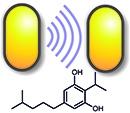Fatal small talk
Brameyer et al. 2015, PNAS (Heermann Lab, Microbiology)
13.01.2015
Bacteria can communicate with each other by small diffusible molecules, a process termed quorum sensing. Many bacteria use acylated homoserine lactones (AHLs) as signals, which are sensed by so-called LuxR-type receptors. With the photopyrones from the insect pathogenic bacterium Photorhabdus luminescens, we recently identified the first quorum sensing molecules different from AHLs that are sensed by a LuxR-type receptor. Here we describe the second novel quorum sensing molecule sensed by a LuxR-type receptor of Photorhabdus species, PauR of the human pathogen Photorhabdus asymbiotica. We demonstrate that P. asymbiotica communicates via dialkylresorcinols (DARs) and cyclohexanediones (CHDs). As the synthesis pathway is widespread, and often present in human pathogens, we discuss DARs and CHDs as novel and widespread signaling molecules. Cited from the Significance statement, Brameyer et al. PNAS, 2015.
A team of researchers led by Dr. Ralf Heermann of the LMU Institute of Microbiology, and Dr. Helge Bode, Merck Professor of Molecular Biotechnology at Goethe University in Frankfurt/Main, characterizes a previously unknown chemical vernacular, which appears to be quite widespread among bacterial species.
Sopie Brameyer, Darko Kresovic, Helge B. Bode and Ralf Heermann (2015) Dialkylresorchinols as bacterial signaling molecules. PNAS. doi: 10.1073/pnas.1417685112
Link zu PNAS Early Edition http://www.pnas.org/content/early/2014/12/30/1417685112


